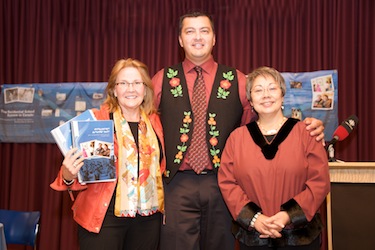How Can We Get Ready for Difficult Histories?
30 November 2012 - 8:09pm
 In my last post I introduced the completion and launch of a grade 10 social studies program The Residential School System in Canada: Understanding the Past - Seeking Reconciliation - Building Hope for Tomorrow for schools in Nunavut and the Northwest Territories. Our Teaching the Past blog has featured pieces about teaching residential schools history in the past (see Katherine Joyce's blog). In the new grade 10 social studies northern program there are 12 activities within the 25-hour program. It begins with engaging students in stories of how children were educated in Inuit or First Nations communities and families before the residential school system, and ends with engaging students actively in local reconciliation initiatives, nurturing hope for different relationships between Indigenous and non-Indigenous peoples in Canada in the future.
In my last post I introduced the completion and launch of a grade 10 social studies program The Residential School System in Canada: Understanding the Past - Seeking Reconciliation - Building Hope for Tomorrow for schools in Nunavut and the Northwest Territories. Our Teaching the Past blog has featured pieces about teaching residential schools history in the past (see Katherine Joyce's blog). In the new grade 10 social studies northern program there are 12 activities within the 25-hour program. It begins with engaging students in stories of how children were educated in Inuit or First Nations communities and families before the residential school system, and ends with engaging students actively in local reconciliation initiatives, nurturing hope for different relationships between Indigenous and non-Indigenous peoples in Canada in the future.
Between the beginning and end, however, students are taken into some very difficult histories. They consider evidence regarding: children being forcibly taken away from home and family, how the Indian residential school system was embedded within other federal policies, different perspectives on the history of colonization in Canada, the “tools of civilization” used in residential schools (including regulating dress, language, contact with family), memories or narratives about attending school from eight different survivors or former students, and the significant layers of intergenerational impacts that continue today.
How do teachers get ready to support entry into these difficult histories? Can teachers ever be completely ready for what may emerge through this learning?
It is important to acknowledge that viewing, reading, discussing or listening to difficult histories always involves risk-taking. It is an inherently unpredictable space that participants (students, teachers, and guest speakers) encounter as their own identities, experiences, and hopes intersect with each other and with stories from the past that involve trauma or conflict. Lisa Farley (2009) points out: “What is difficult about “difficult knowledge” is that it confronts teachers with feelings of helplessness and loss, and the impossibility of undoing what has already happened” (p. 542). She goes on to say: “no matter how meticulous one’s pedagogy and no matter how well planned one’s response, the adult cannot predict the child’s question, nor the meanings that child will make from the knowledge one offers in response” (p. 543).
While teaching and learning difficult histories may present teachers with these unexpected challenges, there is a great deal of support – both preventative and responsive – that can be mobilized to make the classroom more safe for all participants. In the northern residential school history program “Teacher’s Guide,” guidance is devoted to taking measures in this regard, such as:
- Be ready to take care of yourself as the teacher, and identify a peer or friend with whom to debrief or share
- Ensure parents and all school staff (including counsellors) are aware of what you’re teaching, and alert mental health workers in your community if possible
- Discuss with your students the kind of emotions that could occur when learning difficult knowledge, give them permission to display emotions in class and an acceptable place outside of class to take a break if necessary
- Introduce various measures for students to express their reactions – journaling, art projects, or peer conversations (such as talking circles)
- Only extend invitations to guest speakers who are known to you, to another staff member in the school, or experienced sharing their story with students
- Regularly assess student energy levels and be prepared to shift activities or take a break
- Have mental health and wellness supports (ie. toll-free numbers) and resources on hand for students, staff and parents
What measures do you take in your history class to support students, and yourself, in getting ready to engage with difficult histories?
For more resources and supports on teaching the history of residential schools, visit:
The Legacy of Hope Foundation: http://www.legacyofhope.ca/
The Aboriginal Healing Foundation http://www.ahf.ca/publications
The Truth and Reconciliation Commission of Canada, “They Came for the Children”: http://www.trc.ca/websites/trcinstitution/index.php?p=580
Farley, L. (2009) Radical Hope: Or, the Problem of Uncertainty in History Education, Curriculum Inquiry, 39:4, pp. 537-554.
Photo Source: TRC Commissioner Marie Wilson, NWT Minister of Education Jackson Lafferty and Nunavut Premier Eva Aariak (photo courtesy of Government of Nunavut)
- Se connecter ou créer un compte pour soumettre des commentaires

